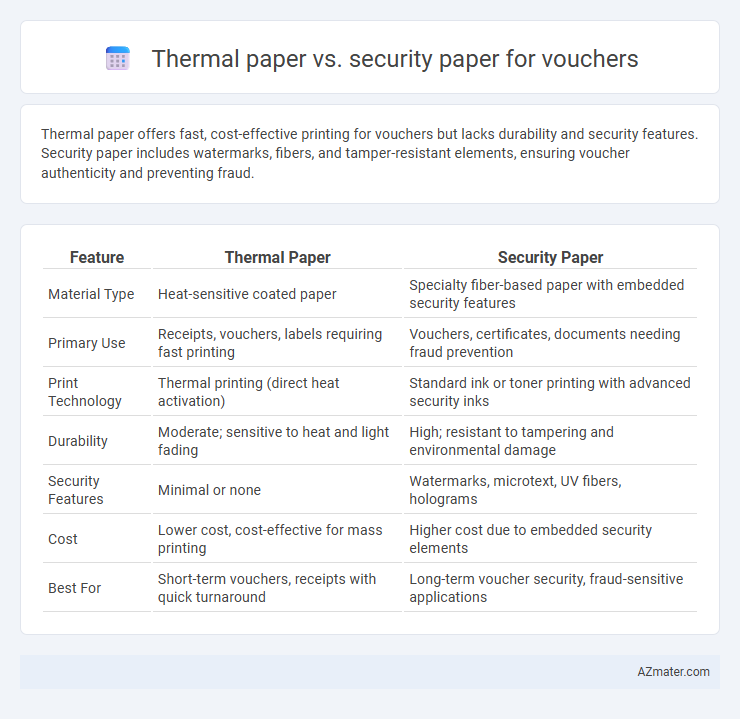Thermal paper offers fast, cost-effective printing for vouchers but lacks durability and security features. Security paper includes watermarks, fibers, and tamper-resistant elements, ensuring voucher authenticity and preventing fraud.
Table of Comparison
| Feature | Thermal Paper | Security Paper |
|---|---|---|
| Material Type | Heat-sensitive coated paper | Specialty fiber-based paper with embedded security features |
| Primary Use | Receipts, vouchers, labels requiring fast printing | Vouchers, certificates, documents needing fraud prevention |
| Print Technology | Thermal printing (direct heat activation) | Standard ink or toner printing with advanced security inks |
| Durability | Moderate; sensitive to heat and light fading | High; resistant to tampering and environmental damage |
| Security Features | Minimal or none | Watermarks, microtext, UV fibers, holograms |
| Cost | Lower cost, cost-effective for mass printing | Higher cost due to embedded security elements |
| Best For | Short-term vouchers, receipts with quick turnaround | Long-term voucher security, fraud-sensitive applications |
Introduction to Voucher Paper Types
Thermal paper and security paper are two primary types of voucher paper used in financial and retail transactions. Thermal paper contains a heat-sensitive coating that produces printed images when exposed to thermal print heads, offering fast and cost-effective printing but limited durability. Security paper incorporates multiple anti-fraud features such as watermarks, microtext, and special fibers, ensuring enhanced protection against counterfeiting and tampering, making it ideal for high-value or sensitive voucher applications.
What is Thermal Paper?
Thermal paper is a special fine paper coated with a heat-sensitive layer that darkens when exposed to a thermal print head, eliminating the need for ink or toner in printing. Commonly used in receipt printers and vouchers, its chemical coating enables fast and clean printing but may fade over time when exposed to heat or light. Security paper, in contrast, incorporates features like watermarks, security fibers, and tamper-evident elements to prevent forgery and enhance document authenticity, making thermal paper less secure for high-value vouchers.
What is Security Paper?
Security paper is a specialized type of paper designed with embedded features such as watermarks, microtext, holograms, and tamper-evident elements to prevent counterfeiting and unauthorized duplication. Unlike thermal paper, which is primarily used for quick, heat-sensitive printing on receipts and vouchers, security paper ensures the authenticity and integrity of vouchers by incorporating advanced anti-fraud technologies. These features make security paper ideal for high-value or sensitive documents where secure verification is critical.
Printing Mechanisms: Thermal vs Security Paper
Thermal paper uses heat-sensitive coating that reacts directly to a thermal printer's heat to produce images, enabling fast and efficient printing ideal for vouchers requiring quick turnaround. Security paper incorporates specialized fibers, watermarks, or embedded security features that work with ink-based printers to prevent forgery and enhance voucher authenticity. The printing mechanism for thermal paper prioritizes speed and simplicity, while security paper printing focuses on integrating complex anti-counterfeit elements for secure voucher issuance.
Durability and Lifespan Comparison
Thermal paper for vouchers offers moderate durability with a typical lifespan of 1 to 3 years, making it susceptible to fading and damage from heat, light, and moisture exposure. Security paper, often embedded with watermarks, fibers, and tamper-evident features, provides significantly enhanced durability and can maintain voucher integrity for over 5 to 10 years under normal handling conditions. The lifespan advantage of security paper makes it ideal for long-term records, while thermal paper suits short-term, cost-effective voucher printing.
Security Features: Fraud Prevention
Security paper for vouchers incorporates advanced anti-fraud technologies such as watermarks, microtext, holograms, and embedded fibers, significantly enhancing counterfeit resistance compared to thermal paper. Thermal paper relies primarily on heat-sensitive coatings that are vulnerable to fading, smudging, and easy tampering, making it less secure for sensitive voucher applications. Utilizing security paper with integrated features ensures robust fraud prevention, safeguarding voucher authenticity and reducing the risk of unauthorized reproduction.
Cost Analysis: Thermal vs Security Paper
Thermal paper typically costs less upfront than security paper, making it a budget-friendly option for voucher printing but may incur higher long-term expenses due to sensitivity to heat and fading. Security paper, while more expensive initially because of its specialized fibers and embedded anti-counterfeit features, offers enhanced durability and protection against fraud, reducing the risk of costly voucher replacements and financial losses. Businesses must weigh the lower immediate cost of thermal paper against the potential added security and longevity benefits of security paper in their cost analysis.
Environmental Impact and Sustainability
Thermal paper often contains BPA or BPS chemicals, raising environmental and health concerns due to toxicity and limited recyclability, while security paper typically uses safer, eco-friendly materials that enhance sustainability. Security paper is generally more durable and designed for longer shelf life, reducing waste from frequent reprints compared to thermal paper's shorter lifespan. Choosing security paper for vouchers supports sustainable practices through better recyclability, lower chemical risks, and reduced environmental footprint.
Industry Applications and Use Cases
Thermal paper is widely used in retail and hospitality industries for printing vouchers due to its speed, cost-effectiveness, and compatibility with thermal printers, providing clear, temporary prints ideal for short-term use. Security paper, embedded with features like watermarks, holograms, and UV fibers, is essential in banking, government, and high-value retail sectors where voucher authenticity and fraud prevention are critical. Choosing between thermal and security paper depends on application requirements such as durability, anti-counterfeiting, and legal compliance in voucher issuance.
Choosing the Right Paper for Your Vouchers
Thermal paper provides cost-effective, quick-printing solutions ideal for high-volume voucher production, but it lacks durability and resistance to tampering. Security paper incorporates anti-counterfeiting features like watermarks, microtext, and UV fibers, enhancing voucher authenticity and fraud prevention. Selecting the right paper depends on balancing budget constraints with the need for secure, tamper-evident vouchers tailored to your business requirements.

Infographic: Thermal paper vs Security paper for Voucher
 azmater.com
azmater.com